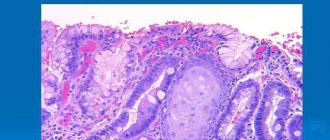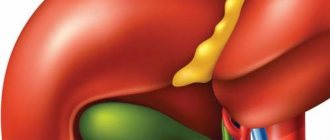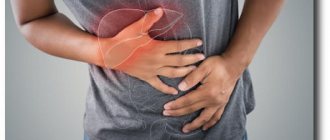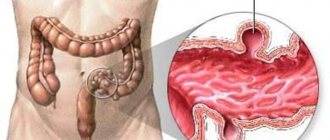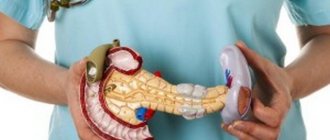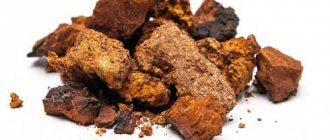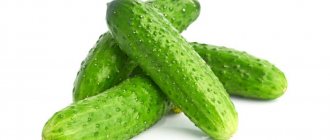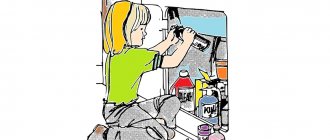Description
Cholestasis is a condition characterized by a slowdown or complete cessation of bile secretion, which is accompanied by an increase in the content of substances secreted along with bile in the blood.
According to statistics, approximately 10 out of 100 thousand people experience cholestasis. It can also be noted that cholestasis is diagnosed in men somewhat more often than in women. In most cases, this pathology is observed in people over 40 years of age.
The most common causes of cholestasis include:
- damage to the liver parenchyma as a result of prolonged consumption of alcoholic beverages, taking medications that have a hepatotoxic effect;
- liver infection;
- congenital metabolic disorders, for example, galactosemia, cystic fibrosis and others;
- inflammatory damage to the bile ducts;
- cholelithiasis;
- acquired or congenital obstruction of the bile ducts;
- sarcoidosis;
- oncological disease of the hepatocellular system;
- hormonal changes in the body, for example, during pregnancy.
Cholestasis is usually divided into the following types:
- intrahepatic - occurs as a result of a decrease in the production of bile and its release into the bile capillaries;
- extrahepatic - in most cases indicates obstruction of the bile ducts.
According to the mechanism of development, the following types of cholestasis occur:
- partial – characterized by a decrease in the amount of bile produced;
- total - bile does not enter the duodenum;
- dissociative – characterized by a decrease in the body’s amount of substances necessary for the production of bile.
As a rule, the prognosis is quite favorable. In most cases, it is possible to achieve complete recovery or long-term remission. This is achieved through timely diagnosis and specialized treatment. In some cases, complications develop, in particular, liver failure may develop, which threatens to disrupt the normal functioning of other organ systems. It is also important to follow preventive measures, which include excluding spicy, fried foods and alcoholic beverages from the diet. In addition, it is necessary to promptly treat the pathology that causes the development of cholestasis.
Prevention of bile stagnation
To prevent bile stagnation, you need to prevent the liver problems that lead to it. It is advisable to vaccinate against hepatitis A and B if you are at risk. Observations showed that bile did not stagnate in those people who led an active lifestyle and followed a balanced diet.
If you experience symptoms similar to bile stasis, contact your healthcare provider for help. This way you can prevent serious complications and start treatment in a timely manner.
Symptoms
Photo: womanadvice.ru
For quite a long time, the only symptom of cholestasis is skin itching, which worries mainly at night and decreases during the day. Severe itching of the skin leads to scratching of the skin, which is dangerous due to secondary infection of these scratches, resulting in pustular rashes. Complaints of pain in the epigastric region or right hypochondrium may also appear. In some cases, there is irradiation of pain to the right shoulder, shoulder blade or right half of the neck. The intensity of pain varies; with the development of biliary colic, the pain becomes unbearable and painful. Dyspeptic disorders manifest themselves in the form of nausea, vomiting, and a feeling of bitterness in the mouth. In addition, as a rule, there is a decrease in appetite, in exceptional cases there is a complete loss of appetite. Decreased appetite over a long period of time leads to weight loss.
Also, the development of cholestasis will be indicated by yellowness of the skin and visible mucous membranes. Most often, the sclera of the eyes turn yellow first. In addition, so-called xanthelasmas, yellowish-brown formations, may appear on the eyelids. As a rule, these formations are small in size and are located symmetrically in most cases. There are also xanthomas, which, unlike previous formations, are located on the chest, back or elbows and have a yellow tint. Since the outflow of bilirubin into the intestines is blocked, as a result of which its removal from the body along with feces is disrupted, discoloration of feces is observed. Also, feces may contain an increased amount of fat, which is associated with impaired digestion of fat supplied with food, resulting from a violation of the flow of bile into the intestines. This phenomenon will be indicated by a “greasy” sheen of feces. In addition, the urine becomes dark in color (the color of beer), which also indicates the possibility of cholestasis.
Since bile is involved in the absorption of vitamins that enter the body with food, with cholestasis a clinical picture of hypovitaminosis is observed. This condition is characterized by the following:
- fatigue, decreased performance and concentration;
- increased drowsiness, especially during the daytime;
- dry skin;
- increased fragility of hair and nails;
- muscle weakness;
- decreased twilight vision;
- increased bleeding of gums.
Diagnostics
Photo: zhdumalisha.ru
When talking with patients, the doctor clarifies the complaints, the time of their onset, and the presence of chronic diseases. As a rule, there are complaints of itching of the skin, discomfort in the epigastric region and right hypochondrium, nausea, occasionally vomiting, and a feeling of bitterness in the mouth. During the examination, yellowness of the skin and visible mucous membranes, and the presence of scratches that can become infected are noted.
Then general laboratory tests are prescribed (general blood count, general urinalysis, biochemical blood test). The picture of a general blood test may remain within normal limits; occasionally a decrease in hemoglobin and an increase in leukocytes are detected. In a biochemical blood test, special attention is paid to the level of bilirubin and its fractions, transaminases, alkaline phosphatase, cholesterol, and GGT. In a general urine test, as a rule, there are no deviations from normal values, but in some cases the appearance of bile pigments is noted.
Of the instrumental research methods, the most accessible and easy to use is ultrasound of the abdominal organs. This study allows you to study the size of the liver and gallbladder, assess the condition of the bile ducts, and also identify the location of duct obstruction. To obtain the most accurate ultrasound result, it is necessary to comply with the preparation for the study, which the attending physician will inform you about in advance. Endoscopic retrograde cholangiopancreatography (ERCP) is also used in the diagnosis of cholestasis. This study is performed by introducing a contrast agent through the major duodenal papilla. Allows you to evaluate not only the condition of the bile ducts, but also the pancreatic duct. It is important to note that this procedure is performed strictly on an empty stomach, which the patient must be warned about in advance.
An invasive way to study the condition of the bile ducts is percutaneous transhepatic cholangiography. Like any invasive procedure, percutaneous transhepatic cholangiography has a number of complications. However, it is worth noting that this method of studying the bile ducts has not lost its relevance, despite its rare use at present.
If necessary, CT (computed tomography) or MRI (magnetic resonance imaging) of the abdominal organs is prescribed, since at present these studies are the most informative non-invasive diagnostic methods.
Cholestasis in pregnant women
Stagnation of bile in pregnant women is a fairly common problem, since hormonal changes occur in the body: the level of progesterone increases significantly, which relaxes all smooth muscle muscles, including the biliary tract.
Also, an important role in the development of urinary stagnation is played by an increase in the size of the uterus and an upward displacement of the abdominal organs, as a result of which the gallbladder or its duct may become kinked.
Most often, signs of cholestasis appear in the third trimester of pregnancy. The clinical picture of bile stagnation in pregnant women is the same as in non-pregnant representatives of the fair sex.
Treatment
Photo: img2.vitaportal.ru
To eliminate the phenomenon of cholestasis, the cause of its occurrence should be identified. In some cases, surgical intervention is required to eliminate the factor that caused the development of cholestasis. For example, if there are stones in the gallbladder, a cholecystectomy is performed.
You should also follow a special diet, which consists of limiting the consumption of fried, smoked and spicy foods. In the diet, it is recommended to replace animal fats as much as possible with fats of plant origin. Preference should be given to vegetables and fruits that contain large amounts of vitamins and microelements necessary for the normal functioning of the body. It is important to choose low-fat varieties of meat products. Low-fat dairy products are also allowed. It is strongly recommended not to forget about the existence of various cereals rich in grains. It is strictly forbidden to consume alcoholic beverages, strong coffee and tea. In addition, it is important to give up bad habits such as smoking and drug use.
The following groups of drugs are used as symptomatic treatment:
- hepatoprotectors necessary to protect hepatocytes (liver cells);
- cholesterol, the action of which is aimed at binding bile salts, thereby eliminating skin itching;
- vitamin K. Used for bleeding associated with cholestasis;
- vitamin or vitamin-mineral complexes. Prescribed when the clinical picture of hypovitaminosis develops.
During the rehabilitation period, non-drug treatment methods are used, the use of which is aimed at stimulating the protective mechanisms of the human body. For example, physiotherapy, massage or physical therapy may be prescribed.
Why does bile stagnation occur?
Bile stagnation is possible inside the liver, inside the bladder, and in both places at the same time.
Causes of stagnation in the liver itself:
- alcoholic liver disease;
- cholangitis with scarring and narrowing of the hepatic ducts;
- chronic and acute viral infections (especially viral hepatitis B or C);
- primary biliary cirrhosis;
- amyloidosis;
- cancer that has spread to the liver.
Causes of bile stagnation in the gallbladder, outside the liver:
- stones or cysts in the bile duct;
- narrowing (stricture) of the bile duct;
- primary sclerosing cholangitis;
- congenital anomalies of the bile duct;
- biliary atresia (lack of bile ducts);
- cancer or inflammation of the pancreas (pancreatitis).
Other reasons:
- sepsis (blood poisoning);
- hypothyroidism;
- certain medications (for example, Amoxicillin, Clavulanate, Chlorpromazine, Azathioprine, combined oral contraceptives);
- sometimes during pregnancy bile stagnation occurs under the influence of hormonal changes, and this is also possible after childbirth.
There is an opinion that bile accumulates and stagnates due to frequent stress and chronic fatigue.
Medicines
Photo: womanjour.ru
The following groups of hepatoprotectors are distinguished:
- essential phospholipids (Essentiale Forte, Antraliv, Phosphogliv), which contain phosphatidylcholine and unsaturated fatty acids. The action of these drugs is to restore the cell wall of hepatocytes, which are largely composed of phospholipids. In addition, essential phospholipids enhance the detoxification function of the liver, prevent the appearance of connective tissue in the liver parenchyma, and also have antioxidant properties. To achieve the desired effect, these products are used for at least six months;
- amino acids (Heptral, Hepa-merz). They participate in the synthesis of phospholipids, which are a structural component of the cell wall of hepatocytes, and have a regenerating and detoxifying effect. It is recommended to use drugs in this group via intravenous administration, since when taken orally, amino acids are metabolized and reach the liver in small quantities;
- vitamins (B1 (thiamine), B6 (pyridoxine), B12 (cyanocobalamin), E (tocopherol)). Facilitate metabolic processes in the liver, thereby promoting the restoration of its cells. As a rule, they are not used as monotherapy, but complement other hepatoprotectors;
- inhibitors of lipid peroxidation (Tiogamma, Berlition). The action of the drugs is aimed at accelerating the removal of lactic acid from liver cells, which has a toxic effect. The formation of lactic acid occurs as a result of the combination of nitrogen with oxygen. These drugs can be prescribed either in the form of injections or in tablet form;
- ursodeoxycholic acid (Ursofalk). Stimulates the removal of bile from the liver, thereby achieving a hepatoprotective effect;
- combination drugs that contain components belonging to several groups of hepatoprotectors (Essel Forte, Phosphonciale, Rezalut Pro, Hepatrin, Sirepar).
In the treatment of cholestasis, preference is given to ursodeoxycholic acid drugs. Essential phospholipids are not used, since their long-term use can lead to stagnation of bile.
When a clinical picture of hypo- or avitaminosis develops, vitamin or vitamin-mineral complexes are prescribed, containing the amount of vitamins and minerals necessary for the normal functioning of the body. Currently, there are a large number of different names of these drugs on the pharmacological market. We offer to your attention the following:
- Revit – contains vitamins A, B1, B2 and C. Suitable for use by both adults and children;
- Duovit is a fairly common representative of vitamin and mineral complexes. Each package of the drug contains red capsules containing vitamins (A, E, C, D3, B1, B2, B5, B6, B12 and folic acid) and blue capsules containing microelements (calcium, phosphorus, magnesium, iron, copper , zinc, manganese, molybdenum). This division of capsules into colors greatly facilitates their use. The fact is that it is recommended to separate the intake of the vitamin and mineral complex on different days, so the created form in the form of blue and red capsules allows you not to get confused in the alternation;
- Teravit. Contains vitamins A, C, D3, B2, B1, E, PP, B5, B6, B12, as well as a number of microelements: calcium, iron, phosphorus, iodine, magnesium, zinc, selenium, copper, manganese, chromium, molybdenum and potassium . Prescribed for adults and children over 12 years of age.
- Supradin. It contains vitamins A, E, C, D2, B1, B2, B3, B5, B6, B9 and B12. The preparation contains the following microelements: calcium, magnesium, phosphorus, copper, iron, manganese, zinc, molybdenum.
As a rule, the duration of taking vitamin or vitamin-mineral complexes is 1 month; if necessary, the course can be extended.
Cholestyramine enhances the excretion of bile acids from the body and also reduces the absorption of cholesterol in the intestine. The drug is available in the form of a powder, which, according to the instructions, is diluted with water. One powder accounts for ½ cup of boiled water. It is important to note that no more than 10 minutes should pass after preparing the solution and before using it. The duration of the course of taking cholestyramine is at least 1 month.
Folk remedies
Photo: Ponchikov.net
As is known, in some cases surgical intervention is required to eliminate the cause of cholestasis. That is why it is strongly recommended not to self-medicate at home, but to immediately consult a specialist at the first symptoms of cholestasis. It is important to understand that the use of traditional medicine in this case will not only not provide any help, but can also cause harm. However, there are folk remedies that can be used for preventive purposes. We offer to your attention the following:
- take 20 g of pre-prepared rose hips and 10 g of crushed nettle leaves. Mix the listed ingredients and pour two glasses of boiling water over them, then place in a water bath and boil for 15 minutes. After which the resulting decoction should be infused for 1 hour, having previously wrapped the container containing the decoction. The drink becomes ready for use after careful straining. It is recommended to consume 50 ml throughout the day;
- Dry the birch leaves and chop them finely. Take 1 tablespoon of plant material and pour one glass of boiling water, then heat over low heat in a water bath for 30 minutes. Then the resulting decoction must be allowed to brew for half an hour, after which it should be strained. It is recommended to consume 1/3 glass 3 times a day 30 minutes before meals;
- mix chopped chicory root and dried peppermint leaves in equal proportions. To prepare the infusion, you will need 10 g of the resulting plant collection. Pour 10 g of the collection into glasses of boiling water and let it brew for 1 hour. After this, the resulting infusion should be filtered through a strainer. One glass of infusion is drunk during the day. The course of treatment varies from 1 week to 1 month;
- Grind 1 glass of flax seeds and pour them with three glasses of milk. Then place on low heat until approximately 1/3 of the original volume of liquid remains in the container. After this, the solution is carefully filtered through a strainer. It is recommended to drink one glass per day. The duration of use of this recipe is 10 days, after which a break is taken;
- take 3 drops of peppermint oil and one teaspoon of honey. Mix the listed components thoroughly. The resulting mass should be consumed 3 times a day. The duration of the course is 1 month;
- mix red beet juice with black radish juice in equal proportions. It is recommended to consume 1 glass per day, preferably in the morning. The duration of the course is 1 month.
The information is for reference only and is not a guide to action. Do not self-medicate. At the first symptoms of the disease, consult a doctor.
